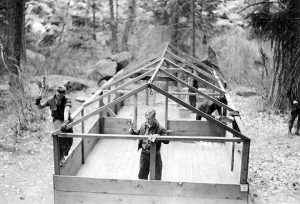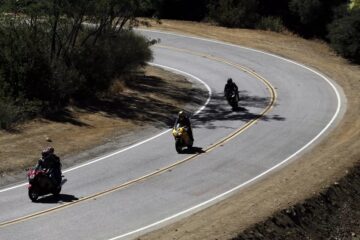National park backers call for creation of a service corps similar to the Depression-era CCC
The Civilian Conservation Corps put millions to work and left a lasting imprint on Yosemite and other parks.
Source of this article – Los Angeles Times, February 1, 2009
By Julie Cart

LANDMARK: Yosemite’s Half Dome is reflected in the Merced River. Civilian Conservation Corps workers did extensive work in the park.
Reporting from Yosemite National Park — The economy was a shambles. Millions of Americans were out of work. Saying something drastic needed to be done, the newly elected president announced a massive economic stimulus package aimed at repairing the nation’s sagging infrastructure and putting people back to work.
The first “emergency agency” established by President Franklin D. Roosevelt was the Civilian Conservation Corps, which eventually put 3 million men to work in the national park system.
By the end of the program in 1942, CCC workers had built scores of bridges, constructed flood-control projects, cut 97,000 miles of fire roads and planted 3 billion trees, prompting the nickname “Roosevelt’s Tree Army.”
The rustic, rock-and-timber buildings and massive lodges constructed by highly skilled artisans are now famously part of the national parks’ visual style, often referred to as “parkitecture.” In parks such as Yosemite — where an unusual number of projects were undertaken — the CCC’s imprint remains.

GIANT SEQUOIA: Members of the CCC’s Camp 5 pose at the now-fallen Wawona Tunnel Tree in September 1934
Now, some in Congress and elsewhere are reaching back to embrace Roosevelt’s Depression-era strategy by calling for a similar parks restoration program to be included in President Obama’s economic stimulus plan. The House version of the bill has $2.25 billion earmarked for projects in parks. The Senate version is still under debate and expected to be voted on Monday.
The CCC was born with the Depression in full roar and one out of four American wage earners out of work. Tens of thousands of unemployed and hungry young men took to the road rather than be a burden to their families.
The Labor Department recruited around the country, and working for the corps became a much-desired job. The program accelerated so quickly — 300,000 men joined in three months — that at the time it was the most rapid large-scale mobilization of men the country had ever witnessed.
Each enrollee signed on for a one-year stint and was paid $30 a month — with a stipulation that $25 be sent home to support their families. In addition to young men, the corps hired what it called LEMs, or “local experienced men,” to lead work in skilled trades.
Former National Park Service Director Roger Kennedy, whose forthcoming book about the CCC and the parks is called “When Art Worked,” said the program was intended to heal the spirit of the workers as well as the nation.
“The CCC was a great deal more than a work program,” Kennedy said. “It was an education and nutrition program. Most of the people who worked there got the first decent meals in their lives. You could see the people growing, literally, eating good food and working hard outside. You can see the transformation in the photographs from the time.”
At Yosemite, Jack Rettinhouse and his mother lied about his age — he was 16 — and signed him up for the CCC in Fresno in 1937.
In a sloppily typed letter in the Yosemite archives recalling his time at the park, Rettinhouse wrote: “I reminber I only weight in at 96 lbs when I went in and after two years I came back to Fresno and weight in at 145 lbs, so I gusse you can say the food wasn’t bad. . . .”
There were some 600 CCC camps in various national parks during the program’s decade of existence. Yosemite had more than most, with 10 encampments scattered throughout the park, from the Valley’s meadows to the high country and atop El Capitan.
Yosemite’s archive contains several colorful histories from corps enrollees who were stationed in the park. The letters of many, who had never been away from home, were filled with wonder at nature.
Darrel E. Stover ended his with this passage: “Yes, I would do it all over again. It was a new life for a nineteen year old kid. I, like so many of the others, inlisted as a teenager and came out a man. And it happened in the most beautiful place in the world, YOSEMITE.”
Each camp housed about 225 workers, living in reinforced tents or wooden barracks. Although the park service directed the work projects, the Army operated the camps, with daily reveille, chow taken in a mess hall and military discipline.
Not long after the program began, an educational component was added, both to train enrollees in job-related skills and to address the widespread problem of illiteracy. Some enrollees taught their compatriots to read and write.
“That’s when science and history and education went into the national park system, in a serious professional way,” said Kennedy, the former park service director.
He said that the still-new idea of national parks gained a foothold as a generation of men connected with wild places. “Environmentalism took its largest forward leap in this country when those people learned it with their hands and with their feet,” Kennedy said.
Filmmaker Ken Burns focuses on the CCC period in one episode of his upcoming six-part documentary to be shown on PBS, “The National Parks: America’s Best Idea.” Surviving CCC members are interviewed, telling how the program transformed their lives.
“FDR called the CCC ‘building human happiness,’ ” Burns said. “The dignity that you see now in the not-at-all-faded memories of people who as teenagers had their lives reformed, they have had their molecules rearranged by being in the CCC.”
Al F. Monteverde joined in 1933 after having no luck finding a job. Upon being sent to Yosemite, he wrote: “We ddint’ know what we wre getting into but we all looked at it like the chance of a lifetime, something to do at last, thank God! Our minds and our bodies would have something to do.”
Work in the park proceeded year-round. Crews constructed the Wawona Tunnel in 1933, cut the May Lake Trail and replaced the climbing cables at Half Dome.
“The park service was poised to help the president because we had master plans sitting on the shelves,” said Yosemite’s chief historian, David T. Humphrey.
The park’s 6,816 CCC enrollees built walls and buildings using rocks and trees in the park. Those projects remain today and help create Yosemite’s rustic look.
“The work was hard, but we loved it,” wrote Leighroy Davis of Waterford, Calif. “Building rock walls on the down hillside of trail, swinging an eighteen pound rock hammer all day plus the pick and shovel was turning boys into men.”
Some of the improvement projects were put to immediate use during the Depression as families from around the region took to camping all summer in the park to save money.

GAINFULLY EMPLOYED: Civilian Conservation Corps workers remove thistles in a Yosemite meadow in 1941.
The National Parks Conservation Assn., a nonpartisan parks advocacy group, has testified before Congress that the nation’s 391 parks have billions of dollars in “shovel-ready projects,” some of them remnants of the system’s more than $8.7-billion maintenance backlog.
Citing the CCC as a model, the parks group is advocating the development of a National Park Service Corps and estimates that investing stimulus funds in parks would create about 50,000 jobs. The group has studied the economic impact of parks, particularly in rural areas, finding that every dollar spent at a park generates $4 in benefit.
Construction projects could be contracted out and stimulate the local economy, said Jon Jarvis, park service director for the Pacific-West region.
“We have literally thousands of those types of projects,” he said. “The infrastructure of the national park system has come in fits and starts. It was massive during CCC; now a lot of those systems are inadequate and failing.”
Jarvis, whose father was in the CCC, said he would like any new park service projects to “set the standard to be as green as possible, to use that bully pulpit to educate the public about what they can do.”
“There’s a legitimate opportunity to make us part of the stimulus package,” said Stephen Martin, superintendent of Grand Canyon National Park, where some 1,000 CCC enrollees labored. “We have a broad need for people to work in parks. We can offer employment programs for college students — help educate them. We require work from engineers and accountants.”






0 Comments